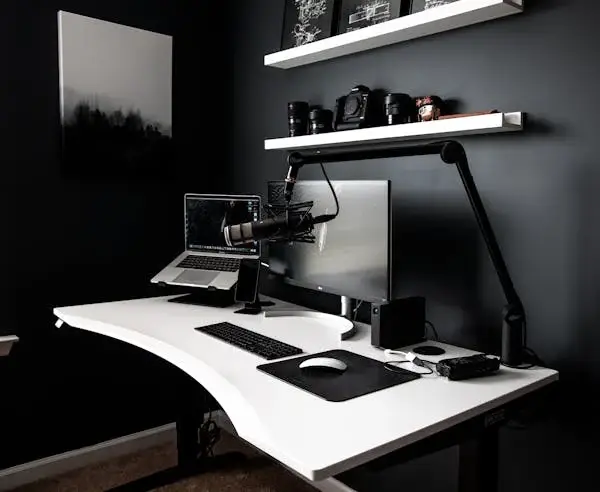
10 Powerful Tips for Creating Ergonomic Workstations for Home Offices – Boost Comfort & Productivity
Over the past few years, home offices have become more common than not. As more people embrace remote working, ergonomic home-office workstations have become essential. You could ask, “what is an ergonomic computing device, and why is it critical?” here’s how to install an ergonomically correct workstation that complements your consolation, increases productivity, and helps you avoid not unusual illnesses.
Which includes lower back pain, eye strain and carpal tunnel syndrome. An ergonomic pc lets you area your frame in a neutral, herbal position that reduces the tension skilled via muscular tissues and joints as you sit down for lengthy durations at a table. Whether your office is a company environment or the comfort of your own home, an ergonomic setup is key to your fitness and well-being.
Getting Started with Ergonomic Workstations
A comfortable and productive home office setup is key to getting work done, especially if you’re sitting at a desk for hours every day. An ergonomic workstation for home offices is purposefully planned to encourage your body to a neutral, healthy stance, minimizing stress and avoiding damage. But what does this mean for you?
It means every aspect of your ergonomic workstation for home offices — including the desk, chair, monitor and even the keyboard — is set up to make physical stress less likely. Ergonomics isn’t all about comfort; it’s about creating an environment that allows for your overall well-being whilst enabling you to work more efficiently. An ergonomic setup at your workstation is not only important for avoiding discomfort, but it can also help you focus and work efficiently for the entire day.
Computer workstation with reminders: What is an Ergonomic Workstation?
An ergonomic workstation for home offices: What is it? In Closer to the Workplace: What is An Ergonomic Workstation for Home Office? They call this setup the ergonomic workspace, which typically consists of a properly arranged desk, a supportive chair, and other accessories such as footrests, keyboard supports, and wrist rests — all created to help keep your body as neutral and healthy as possible.
An ergonomic workstation prevents common problems like back pain, neck strain, and eye discomfort when you sit still and too long by optimizing all aspects of your workspace, from desk height to screen distance. Whether working full-time or just two or three days a week from your home office, a well-designed ergonomic workstation ensures all-day health and focus.
Why Do Ergonomics Matter in Home Offices?
While you work from home, you may not have the luxury of a workplace with adjustable chairs or desks. That’s why creating ergonomic workstations for home workplaces is so crucial. Without the proper setup, you can experience muscle fatigue, eye stress, and continual aches, ultimately affecting your productivity and well-being.
The importance of ergonomics lies in its capability to guide your frame’s natural posture, reduce bodily strain, and create a more secure environment for long work hours. By investing in ergonomic furniture and add-ons, you could lay out a laptop that promotes higher fitness and boosts your painting’s overall performance. Right ergonomic setups are not the most effective way to limit discomfort; however, they also improve consciousness, mainly due to greater performance and fewer breaks because of physical strain.
How to create an ergonomic workstation
So, what does an ergonomic workstation for home offices entail? The success of the strategy can be attributed to several key components. Let’s break them down.

Desk Design and Layout
Desk: A home office’s ergonomics foundation must be roomy enough to accommodate all your equipment, from your computer to notebooks and office supplies, with everything kept within reach. An ergonomic desk layout helps you be more efficient, reduce unnecessary stretching , and maintain your workflow. The ideal workspace allows you to remain productive without reaching or straining your body to get a tool, hard drive, or file.
Reducing mental stress, in part, requires a clean desk. Studies suggest that an organized work environment can help minimize distractions and improve focus, making it more likely that you can be efficient. As you set up your desk, consider ergonomics — you want your keyboard and mouse positioned to lessen the strain on your hands and your monitor to be at eye level so you don’t strain your neck.
For optimal ergonomic workstation use in home office settings, consider selecting a desk with adjustable height settings to switch between a sitting and standing position throughout the workday. This mobility is fundamental in diminishing the risks of extended sitting and enhancing your starting posture and energy levels.
How to Decide Which Desk Height Is Right for You
The ergonomic table peak is one of the most vital concerns when designing a domestic workplace pc that supports your posture and minimizes pressure. The correct height allows your fingers to be bent at a ninety-degree angle, and your elbows and wrists remain as comfy as you are. This may dramatically lessen wrist pressure and help you hold a better posture.
One common desk detail to look out for: Your elbows should be either level or slightly lower than the desktop when sitting at your desk. Your wrists should be, as they say, straight when you’re typing, and the keyboard should be positioned at a height that lets you do that without hunching your hands and putting yourself at risk for repetitive stress injuries like carpal tunnel syndrome. If you want to do that, you need to find a desk height adjustable to set it based on what you want.
For users of standing desks, desk height should be adjusted such that your forearms are parallel to the ground and your shoulders remain relaxed. This also prevents strain on the neck, back and arms while standing, greatly improving posture and overall comfort during the day.
Choosing the right desk height will dictate whether your home office ergonomic workstation allows you to work comfortably in a healthy position and promotes productivity without sacrificing comfort or productivity.
The Importance and Selection of Ergonomic Chairs
A good ergonomic chair is essential for home office ergonomic workstations. Long hours slumped at your desk can cause discomfort, muscle fatigue, and chronic pain if you’re not properly supported in your chair. A good ergonomic chair is known to try to reduce such problems with a better sitting position and less stress on your body. It also provides decent lumbar support, keeps your spine aligned better, and promotes natural sitting posture, which are all helpful for keeping you comfortable and functional over a workday.
Choosing a Chair for Your Home Office Ergonomic Workstation: You should find a chair with adjustable height, seat depth and armrests. Adjustability — Provides a customizable fit to make your chair unique to your body type and sitting style. For example, an adjustable chair will help mitigate the discomfort associated with remaining sedentary in one position for long periods. It can be personalized to accommodate a range of different seated postures.
Special Features: Chair Adjustability and Lumbar Support
The lumbar support in your chair is one of the key features of an ergonomic workstation at home. It should conform to the natural curve of your spine and support your lower back to prevent slouching. This can lower the risk of back pain, an all too typical problem for anyone spending lengthy hours in the same location. A good chair with lumbar support promotes a more neutral position for sitting, which translates to your spine staying aligned as you work.
Other features like a lumbar aid and adjustable armrests are crucial for preserving true posture while typing or using a mouse. Your hands must cling at a 90-degree attitude, and your wrists should be impartial to save extra pressure on your forearms and wrists. Absolutely customizable and adjustable armrests are also critical so you can place your palms in the perfect position and avoid repetitive strain accidents.
An office chair with these characteristics will form an ergonomic workplace for home offices that keeps your back and arms well supported while also providing comfort overall and helping you stay comfortable and productive throughout the day!
Factors That Can Influence Monitor Placement and Settings
Monitor placement is an important component of creating ergonomic workstations for home offices that minimize strain on the neck and eyes. Cock-eyed posture can lead to discomfort and long-term health problems when using a screen for too long. A proper monitor placement also ensures that you maintain a neutral posture and do not unnecessarily flex or stress your body while working, enabling you to work more efficiently and comfortably throughout the day.
The top of the screen should be at or below eye level, enabling you to look straight ahead without tilting your head up or down. This adjustment encourages healthy neck posture, preventing strain on your neck muscles. Your monitor should also be an arm’s distance from your eyes. This reduces eyestrain and makes sure you’re working at a comfortable, healthy distance from the screen.
Ideal Monitor Viewing Angle and Distance
For your ergonomic workstation for home offices, place your monitor approximately 20 to 30 inches away from your eyes or about arm’s length to avoid eye strain and neck discomfort. Tilt the screen slightly at 10 20-degree angles for glare reduction and easier reading without straining the eyes.
Ensure the top of the screen is at the level of your eyes when sitting comfortably so you can simply glance at the screen without altering your posture or neck. Knowing the proper positioning for your monitor can help mitigate a lot of neck, shoulder, and eye strain, allowing you to create the healthiest, most comfortable home office possible.
Accessories for the Home Office Ergonomics
Along with the essential features of your ergonomic home office workstation, you may also wish to add elements that will improve comfort, support, and overall productivity. These additions are meant to work with the primary aspects of your workspace, bringing even more health and efficiency to your environment.

Keyboard and Mouse Setup
The way you function your keyboard and mouse can significantly effect your wrists, forearms and shoulders. when setting up an ergonomic workstation for the house office, each keyboard and mouse should be placed so that your forearms are aligned parallel to the ground while you are typing and your wrists are in a immediately but cozy function. This puts less pressure in your wrists and lowers the chances of repetitive stress injuries such as carpal tunnel syndrome.
For maximum comfort, look for a split keyboard or one with a negative tilt, enabling the hands to stay more natural. An ergonomic mouse, designed to fit the shape of your hand, can help reduce wrist strain and encourage general ergonomics. These aspects must be in place to avoid and mitigate pain and maintain an active and productive workstation.
Footrests and Other Other Supportive Accessories
Footrests are essential if your home office workstation isn’t perfectly suited to your height. A footrest is a great tool when your chair seat is too high to keep your feet flat on the floor to stop leg and lower back strain. That helps you sit better, decreasing discomfort from poor seating posture.
Ergonomic wrist rest and mousepad assist with your special purpose and make a big difference. For example, wrist rests cushion your wrists when you type, which helps keep them neutral and avoids putting pressure on your delicate wrist joints. An ergonomic mousepad can provide extra comfort, limiting friction with horizontal surfaces while supporting your wrist’s natural position during work. A few small tweaks can vastly improve the comfort of your ergonomic workstation for homeworkers and reduce the strain of everyday tasks.
Ergonomic Workstations and their Health Benefits
Whether you’re spending the entire day in it or sneaking work in after hours, an ergonomic workstation for your home offices is definitely about their comfort. Still, more than that, it’s their health and how that comfort can significantly improve your well-being over time. Here’s a closer examination of how these setups can help positively influence your health and work life.
Musculoskeletal Disorder Prevention
Spending lengthy hours on a poorly designed laptop can cause musculoskeletal problems (MSDs) like again pain, neck ache, and carpal tunnel syndrome. Those situations are commonplace among those who sit for extended intervals without proper guidance or posture. However, an ergonomic workstation for domestic places of work can assist in preventing these issues by selling proper posture, aligning your spine, and providing vital guidance on your frame.
Utilizing ergonomic features in your workplace, like an adjustable chair with lumbar support, a desk at a proper height and a monitor positioned within an optimal range, can greatly eliminate strain from your muscles and joints. Improved posture and reduced strain mean that you are less likely to develop chronic conditions in the long term, such as back pain or repetitive stress injuries, enabling you to remain healthier overall.
Increasing Productivity and Lessening Exhaustion
When you’re comfy, you’re more centred and green. One of the predominant benefits of an ergonomic notebook for domestic places of work is that it enables less physical pain, often resulting in distractions and breaks. With a setup that encourages desirable posture and reduces stress on the body, you may paint for longer durations without feeling fatigued or experiencing aches and pains.
Ergonomic workstations help lessen bodily fatigue, meaning you don’t feel as tired after a protracted day. This increased comfort interprets to higher productiveness and cognizance, as your frame isn’t always constantly reminding you of discomfort. By feeling bodily supported, you could listen better in your tasks, live engaged, and perform at your pleasant, in the long run enhancing your painting’s overall performance and output.
How to Create an Ergonomic Home Workspace
Setting up an ergonomic workstation in a home office doesn’t need to be rocket science. There is a range of industry-standard practices that you can use to make your desk space a much nicer environment. Here is a step-by-step approach to getting started:

How to Set Up Your Desk [With Step-by-Step Guide]
- Choose the Right Desk
step one in putting in place an ergonomic computer for home offices is choosing a desk that meets your desires. Ensure your table has sufficient area to accommodate your system, consisting of your pc, keyboard, mouse, and other gear you operate daily. Moreover, the desk must be at a top that lets your arms stay at a ninety-degree perspective even as typing, keeping your wrists comfy and your shoulders secure. Choose a table with adjustable peak capabilities if you decide on the power to trade between sitting and standing. - Invest in a Good Chair
An easy chair is a cornerstone of any ergonomic notebook for home places of work. Search for a chair that provides lumbar aid to maintain the herbal curve of your backbone. The chair ought to be adjustable on top so you can discover the perfect function that keeps your toes flat on the ground and your thighs parallel to the ground. Armrests should also be adjustable to ensure your palms are nicely supported and on the proper top to lessen stress on your shoulders and wrists. - Get Your Monitor in the Right Place
Monitor placement is a key ergonomic home office workstation component and helps limit neck and eye strain. Place the monitor so that the top of the screen is at eye level and about an arm’s length away. This means you can face forward without craning your head, which helps maintain good neck posture and prevents eye fatigue. For multiple monitors, have the monitors aligned at the same height and distance so you have a constant angle of view. - Set Up Your Keyboard and Mouse
Your keyboard and mouse setup is important for averting strain on your wrists and forearms. Region the keyboard at a height that allows your arms to stay comfy and your wrists immediately while typing. The mouse should be positioned close to the keyboard to minimize reaching, keeping your arms and shoulders relaxed. Consider using a split or negative-tilt keyboard for added comfort. A mouse with ergonomic design features can also help reduce wrist strain. - Use Ergonomic Accessories
You can also add accessories like footrests, wrist rests, and mousepads to complement your ergonomic workstation for the home office. A footrest is especially beneficial for people whose desks are too high or have shorter stature. It also helps flatten your feet on the floor to prevent straining your legs and lower back. Wrist rests, and ergonomic mousepads can help reduce pressure on your wrists and maintain a neutral position while typing or using the mouse to prevent repetitive stress injuries.
Over time, they may cause your wrist to bend and put pressure on them if you place them in the wrong position while setting up your keyboard and mouse. Your keyboard and mouse setup is important for avoiding wrist and forearm strain. Position the keyboard at a height where your elbows are relaxed, and your wrists are straight while typing.
Apply the mouse to the same tie to minimize reach, keeping your arms and shoulders relaxed. Your keyboard can add to your comfort, too — you can consider using a split or negative-tilt version. An ergonomically designed mouse could also alleviate some wrist strain, although that’s a distant concern from most ergonomics experts.
Affordable Ergonomic Offers
Many people don’t want to spend on ergonomic furniture at a price so high, but setting up an ergonomic workstation for a home office doesn’t have to be a massive outlay. Many of these are nicely cheap, bringing major comfort and less strain. Setting a higher standard doesn’t have to cost a lot; small changes can make your workspace healthier — and more productive.
- Adjustable Laptop Stands
You could also try an adjustable laptop stand to help raise your screen to eye level (if you work on a computer) to help reduce neck strain. Considering these stands are cheap and easy to transport, they’re one of the better solutions for improving your working-from-home posture. For better ergonomics, attach an external keyboard and mouse. - This includes ergonomic mousepads and keyboards.
You can invest in an ergonomic mousepad with wrist support to rest your mouse hand. Similarly, a budget model split or negative-tilt keyboard can aid in keeping your wrists in a neutral position, minimizing the risk of repetitive stress injuries. - Inexpensive Footrests
A simple footrest will improve your posture, especially if your desk is too high or your chair is not adjustable. Footrests are cheap and can ensure your feet are flat on the floor, relieving pressure on your lower back and legs.
These little alterations can improve the ergonomics of your at-home workspace without having to shell out thousands of dollars.
Do’s and Don’ts of Ergonomic Setups
Many people make basic errors when setting up their home offices with ergonomic workstations, meaning they are not getting all the benefits from their ergonomic furniture and accessories. Here’s a look at some common mistakes to watch out for:
False Desk and Chair Heights
One of the most unusual errors in an ergonomic setup is having a table that’s too high or too low. If your desk isn’t at the proper peak, it may cause you to hunch forward or enlarge your fingers at awkward angles, leading to neck and back pain. Furthermore, if your chair is too low or doesn’t offer the right lumbar help, it can pressure your returned and legs, contributing to soreness at some point in the day. Usually, alter each of your tables and chairs to ensure that your elbows are at a ninety-diploma attitude and your toes are flat on the ground.
Working with Ergonomic Equipment and Poor Posture
Having ergonomic furnishings is an extremely good beginning. However, it’s now not enough if you don’t preserve the right posture. Slouching or leaning forward can counteract the advantages of your ergonomic notebook. To get the full benefits, ensure you sit along with your back instantly, your shoulders comfy, and your feet flat on the ground. Your wrists must be direct whilst typing, and your head must be aligned with your backbone, not tilted forward or backward.
You can create a supportive and comfortable workspace that promotes higher health and productivity by averting those not-unusual mistakes and following ergonomic concepts.
Conclusion
Designing an ergonomic workspace in your home office is a must for your well-being, comfort, and productivity, and it is not negotiable. Investing in the right desk and a supportive ergonomic chair, placing the monitor at eye level, incorporating accessories that aid your work habits, and so on can help you optimize your home office to promote well-being and efficiency.
Remember that even minor tweaks — like raising or lowering your chair or putting your feet in a footrest — can hugely affect how much physical stress and discomfort you experience. Focusing on ergonomics at your workspace helps you build greater focus, higher levels of productivity, and better long-term fitness. Switch today and enjoy the advantages of a genuinely ergonomic desk chair and set up for your home study! If you need office chairs that won’t break the bank, this guide on the Best Affordable Ergonomic Office Chairs is for you.
FAQ Section

